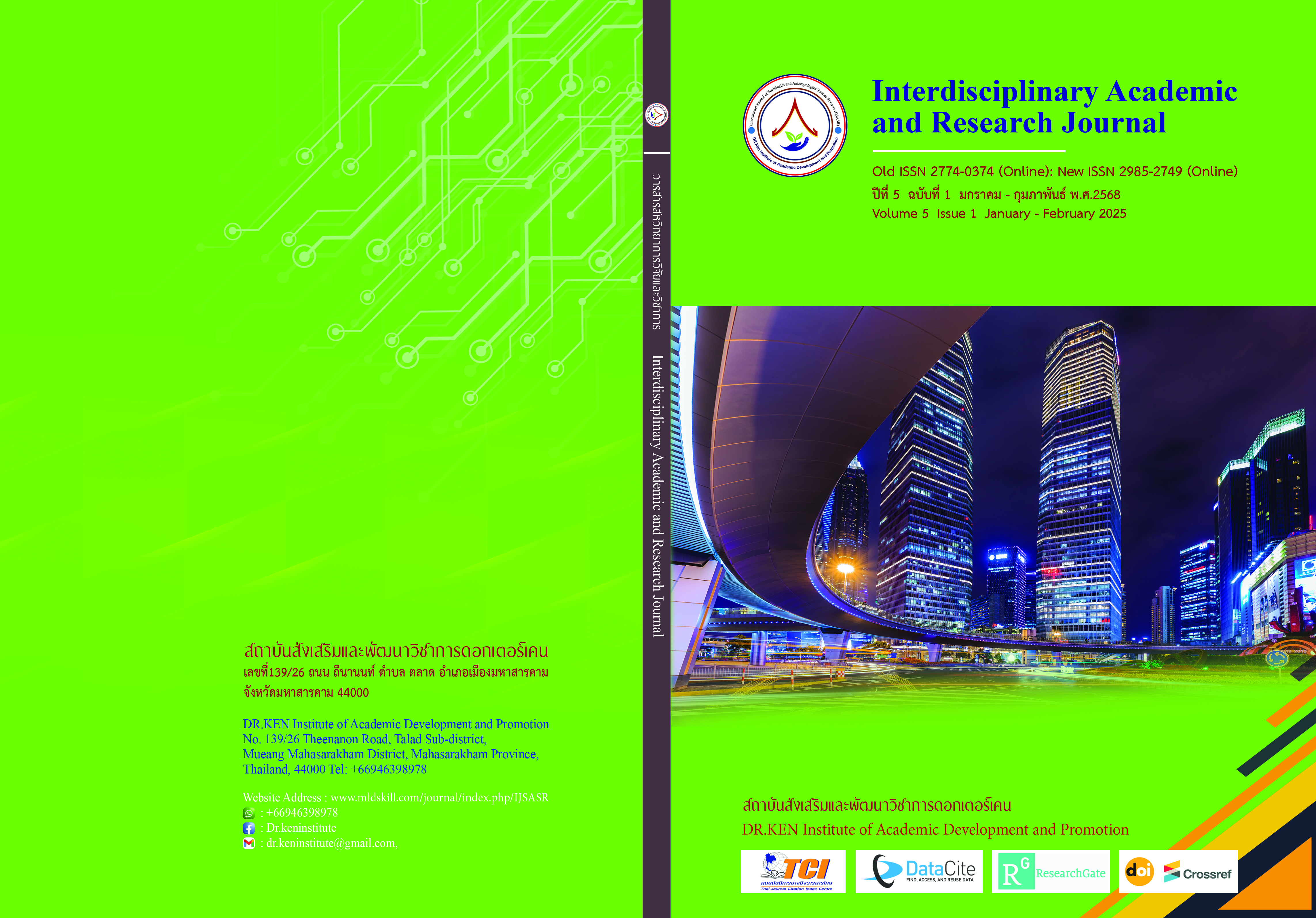The Study of a Learning Management Model for Thai Reading Based on Constructivist Theory in Conjunction with Cooperative Learning to Enhance Reading Competency for Grade 6 Students
DOI:
https://doi.org/10.60027/iarj.2025.280092Keywords:
Learning Management Model, Constructivist Theory, Cooperative Learning, Reading CompetencyAbstract
Background and Aims: Organizing learning to read Thai that will Somprasong Klinjek promote students' reading ability. Teaching methods and learning management formats must be adjusted accordingly, which will help develop and encourage students to have increased reading ability. Become a learner in the 21st century who has the ability to read and create knowledge. and applying knowledge to develop creativity into innovations in reading. The aims of this research were to: 1) study the basic data and elements of a learning management model for thai reading based on constructivist theory in conjunction with cooperative Learning to enhance reading competency for grade 6 students, and 2) develop a learning management model for thai reading based on constructivist theory in conjunction with cooperative Learning to enhance reading competency for grade 6 students.
Methodology: This research used a mixed-method research which was conducted through 2 interrelated stages. Stage 1; the synthesis of components an instructional model and approved by 11 educators using the delphi technique and Stage 2; the developing of an instructional model and approved by 5 educators. The sample group was students in Prathom 6/2 at Sankhaburi Kindergarten School. Under the Chainat Primary Educational Service Area Office, 30 people are studying in the second semester of the 2023 academic year. The tools used in the research were: 1) Assessment of basic information and elements of the learning management model 2) Assessment of the quality of the learning management model and 3) Reading competency assessment for grade 6 students. The statistics used in this research included the percent mean and standard deviation.
Results: 1. The results of the study of the basic information and components of the learning management model found that the basic information of the learning management model includes: 1) conditions for learning to read thai, 2) learning management format, 3) reading competency, and 4) components of reading competency. As for the elements of the learning management model, it consists of 5 elements: 1) principles, 2) objectives, 3) contents, 4) learning management processes, which consists of 5 steps: (1) Step of surveying previous experiences Adding new knowledge (2) Problem setting and grouping step (3) Research and practice step (4) Development and application step, can be extended (5) Evaluation step exchange knowledge and 5) measurement and evaluation. and 2. The results of evaluating the quality of the developed learning management model found that the learning management model was appropriate at the highest level ( \bar{x} = 4.73, S.D.= 0.11)
Conclusion: Research results indicate that learning management model for thai reading based on constructivist theory in conjunction with cooperative Learning to enhance reading competency for grade 6 students, this development can be used in organizing learning activities. As a result, learners will have learning outcomes that reflect the development of abilities, skills, and attitudes, being able to integrate knowledge and apply it in real life and students learn through grouping processes It will help develop and encourage students to have increased reading ability.
References
กระทรวงศึกษาธิการ. (2567). ประกาศกระทรวงศึกษาธิการ เรื่อง นโยบายและจุดเน้นของกระทรวงศึกษาธิการ ประจำปีงบประมาณ พ.ศ. 2567 - 2568. กรุงเทพฯ: กระทรวงศึกษาธิการ.
กุลิสรา จิตรชญาวณิช และมาลี บุญคง. (2565). รูปแบบการจัดกิจกรรมการเรียนรู้ตามแนวคิดการใช้สมองเป็นฐานเพื่อพัฒนา การอ่านออกเขียนได้ภาษาไทยของนักเรียนชั้นประถมศึกษาปีที่ 1. วารสารวิชาการ Journal of Roi Kaensarn Academi ศูนย์พัฒนาการเรียนรู้สมัยใหม่, 7(3), 308–323.
ฉัตรปวีณ อำภา และประไพศรี โห้ลำยอง. (2566). การพัฒนารูปแบบการเรียนรู้โดยใช้กลวิธีอภิปัญญาเพื่อส่งเสริมความสามารถในการอ่านเพื่อพัฒนาทักษะการแก้ปัญหาของนักศึกษาปริญญาตรีชั้นปีที่ 2. วารสารวิชาการ Journal of Roi Kaensarn Academi, 8(5), 66-82.
ดวงจันทร์ เดี่ยววิไล และธนพร หมูคำ. (2564). การสร้างแบบทดสอบวัดสมรรถนะการอ่านสำหรับนักเรียนชั้นประถมศึกษาปีที่ 4 – 6 โดยการหนุนเสริมจากภาคีเครือข่ายการเรียนรู้. วารสารศึกษาศาสตร มหาวิทยาลัยขอนแกน, 44(4), 132–145.
ทิศนา แขมมณี. (2564). ศาสตร์การสอน : องค์ความรู้เพื่อการจัดกระบวนการเรียนรู้ที่มีประสิทธิภาพ. (พิมพ์ครั้งที่ 25). กรุงเทพฯ: สำนักพิมพ์จุฬาลงกรณ์มหาวิทยาลัย.
บุญชม ศรีสะอาด. (2558). การวิจัยเบื้องต้น. (พิมพ์ครั้งที่ 9). กรุงเทพฯ: สุวีริยาสาส์น.
ปัญญาวิทย์ แจ่มกระจ่าง. (2564). การพัฒนารูปแบบการจัดการเรียนรู้การอ่านเชิงรุกเพื่อส่งเสริมความฉลาดรู้ด้านการอ่านและผลสัมฤทธิ์ทางการเรียน สำหรับนักเรียนชั้นมัธยมศึกษาตอนต้น. วิทยานิพนธ์ปรัชญาดุษฎีบัณฑิต สาขาวิชาหลักสูตรและการสอน บัณฑิตวิทยาลัยมหาวิทยาลัยราชภัฏวไลยอลงกรณ์ ในพระบรมราชูปถัมภ์.
ศักดิ์ดา เปลี่ยนเดชา. (2560). การพัฒนารูปแบบการจัดการเรียนรู้การอ่านเชิงรุกเพื่อส่งเสริมความสามารถในการอ่านเชิงรุกและความสามารถในการเขียนเชิงสร้างสรรค์ของนักเรียนชั้นมัธยมศึกษาตอนต้น. วารสารวิชาการศึกษาศาสตร์ ศรีนคริทรวิโรฒ, 19(1), 218–233.
สำนักงานคณะกรรมการพัฒนาการเศรษฐกิจและสังคมแห่งชาติ. (2562). ยุทธศาสตร์ชาติระยะ 20 ปี (พ.ศ. 2561-2580). กรุงเทพฯ: สำนักนายกรัฐมนตรี.
สำนักงานเลขาธิการสภาการศึกษา. (2565). รายงานการศึกษารูปแบบการจัดการเรียนรู้สำหรับนักเรียนระดับการศึกษาขั้นพื้นฐานที่ได้รับผลกระทบจากสถานการณ์โควิด 19. กรุงเทพฯ: กระทรวงศึกษาธิการ.
สำนักงานอุทยานการเรียนรู้. (2562). เข็ม : สำรวจปรากฏการณ์และความเปลี่ยนแปลง 10 ปี ทศวรรษแห่งการอ่าน พ.ศ. 2552-2561. กรุงเทพฯ : สำนักนายกรัฐมนตรี.
สำนักทดสอบทางการศึกษา. (2565). แนวทางการวัดและประเมินผลในชั้นเรียนในสถานการณ์การแพร่ระบาดของโรคติดเชื้อไวรัสโคโรนา 2019 (COVID - 19). กรุงเทพฯ: กระทรวงศึกษาธิการ.
Eric Sheninger. (2018). Educational Makerspace. New Jersey High School Getting Creative with Makerspace. Retrieved on June 17, 2023, from https://www.thekommon.co/makerspace-for-education.
Johnson, D. W., Johnson, R. T., & Holubec, E. J. (1987). Circles of learning: Cooperation in the classroom. (3rd ed.). Edina MN Interaction Book Company.
Joyce, B., Weil, M., & Calhoun, E. (2017). Models of teaching. Allyn & Bacon.
Piaget, J. (1963). The origins of intelligence in children. W.W. Norton & Company, Inc.
Sheng, L. (2010). A development of Thai language pronouncing instructional model using phonetic alphabet and personal interaction for Chinese students. Burapha University.
Vygotsky, L. (1978). Interaction between learning and development. Harvard University Press.
Downloads
Published
How to Cite
Issue
Section
License
Copyright (c) 2025 Interdisciplinary Academic and Research Journal

This work is licensed under a Creative Commons Attribution-NonCommercial-NoDerivatives 4.0 International License.
Copyright on any article in the Interdisciplinary Academic and Research Journal is retained by the author(s) under the under the Creative Commons Attribution-NonCommercial-NoDerivatives 4.0 International License. Permission to use text, content, images, etc. of publication. Any user to read, download, copy, distribute, print, search, or link to the full texts of articles, crawl them for indexing, pass them as data to software, or use them for any other lawful purpose. But do not use it for commercial use or with the intent to benefit any business.
















.png)


